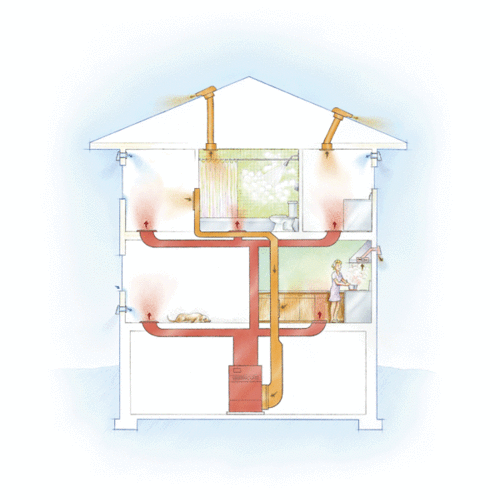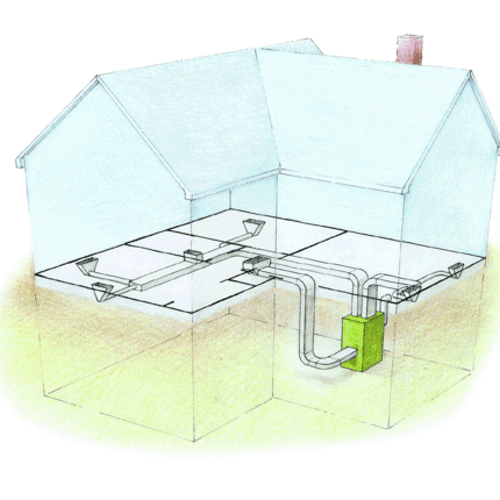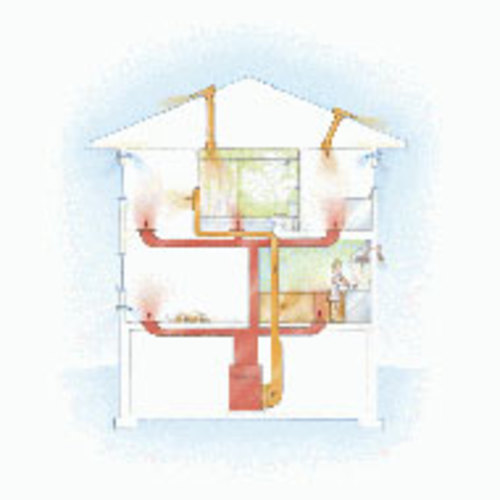ABOUT BALANCED VENTILATION
Supplying fresh air while exhausting stale air
A balanced ventilation system uses a supply fan to introduce the same volume of fresh outdoor air that is being simultaneously removed from the house by an exhaust fan. These systems are more complex than supply-only or exhaust-only ventilation systems, but provide better fresh air distribution and in some cases lower energy bills than alternative systems.

This article is only available to GBA Prime Members
Sign up for a free trial and get instant access to this article as well as GBA’s complete library of premium articles and construction details.
Start Free TrialAlready a member? Log in










12 Comments
Balanced Ventilation
Hi Martin,
Kind of surprised your graphic does not show independently ducted system considering your recommendations on this regard.
Can you also caution your readers against terminating any type of interior air flow to soffit areas (especially when soffits are perforated like here in the Pacific North-West). The warm moist air is just sucked back into the attic cavities where it condenses on the cold surfaces and causes moisture problems including mould.
Response to Sean Wiens
Sean,
I agree that exhaust ducts should not terminate at soffits. Fortunately, this article neither recommends nor illustrates that practice.
The HRV ducting illustration was pulled from a different source; I agree that connecting an HRV to forced-air ductwork is an inferior installation compared to an HRV with dedicated ventilation ductwork.
Here is a simplified drawing showing dedicated HRV ductwork; the illustration appeared on a Web site maintained by the Office of Energy Efficiency of Natural Resources Canada (http://www.oee.nrcan.gc.ca/Publications/infosource/Pub/hrv/hrvsystem.cfm?text=N&printview=N):
The link is dead
Nils,
You're right -- the link is dead, and I can't find the site anymore. However, I think that the illustration I intended to share is the one below.
For more information on this topic, see "Ducting HRVs and ERVs."
600 cm/h range hood fan
In a well sealed house with minimised air infiltration and HRV system provides for air exchange and heat recovery. My concern is when a commercial rated kitchen range hood is operating - this removes a significant volume of air (say 600 cu m per hour). If there is a wood fire in operation, is it possible to create a negative pressure inside the house which might draw CO gases down the fireplace flue and into the house. How can the system be set up to ensure a balanced ventilation when the fireplace and range-hood are operating?
Response to David Mackenzie
David,
An HRV provides balanced ventilation, as you point out, not makeup air. If you want to have a 600-cfm range hood, you need to install a source of makeup air -- and an HRV can't do that.
Here's more information: Makeup Air for Range Hoods.
Balanced Ventilation - formula or minimum CFM?
Martin,
I work for an HVAC company in Houston, TX, and we have developed a focus on installations for LEED and E-Star 3.0 homes.
I have a question regarding "Balanced Ventilation." Is there a formula or minimum ventilation rate that is required when utilizing a balanced ventilation system? For example, we have a home that requires 60 CFM of continuous mechanical ventilation (per ASHRAE 62.2 - 2007 formula).
We do not want to bring in fresh air continuously (100% of the time) due to our climate. Is there a formula or quantitative method to define us bringing in 60 CFM for 50% of the time, and exhausting (via continuous running exhaust fans) 30 - 60 CFM 100% of the time?
I know this is a stretch, but I cannot find any type of formula that sets minimum supply / exhaust rates for a "balanced ventilation" design.
Thank you for your time!
Response to Jerry Krieg
Jerry,
If you "do not want to bring in fresh air continuously (100% of the time) due to our climate," switching to 60 cfm of exhaust ventilation for half of the day will not solve your problem, because an equal volume of outdoor air will enter your house through cracks to make up for the exhausted air when the exhaust fan is running.
Whether you choose a balanced ventilation system or an exhaust ventilation system, you are introducing outdoor air into the house in either case.
Response to Jerry Krieg
Martin,
Thanks for the quick reply. So do you know of any formula or minimum ventilation rate that is required when utilizing a "balanced ventilation" system?
Would ASHRAE expect HVAC contractors to use the same 62.2 - 2007 formula to determine necessary CFM levels for mechanical ventilation (supply)? Then expect the same CFM levels for the exhaust?
If we bring in 60 CFM 50% of the time and exhaust 30 CFM 100% of the time...is that an acceptable balance? I'm trying to find some guidance on CFM levels from ASHRAE, but I cannot locate a formula dedicated to "Balanced Ventilation."
Thanks again!
Response to Jerry Krieg
Jerry,
The amount of fresh air introduced to a building by a 60 cfm balanced ventilation system (60 cfm in, and 60 cfm out) is the same as the amount of fresh air introduced to a building by a 60 cfm exhaust ventilation system. It's impossible to exhaust 60 cfm without 60 cfm of makeup air finding its way indoors.
In either case, a ventilation system designer needs to follow the ASHRAE 62.2 formula. For more information on determining ventilation rates, see Designing a Good Ventilation System.
30 CFM exh 100% & 60 CFM Supply 50%
Thanks for the reply and link to the article.
Do you have an opinion on running an exhaust / ventilation system at 30 CFM 100% of the time, and bringing in fresh air from the outside (supply) at 60 CFM, 50% of the time?
Would that be considered "Balanced?"
Response to Jerry
Jerry,
Your proposed ventilation system would work, if that's what you want to do.
You can call it whatever you want. I don't think the phrase "balanced ventilation" is regulated by law.
Log in or become a member to post a comment.
Sign up Log in